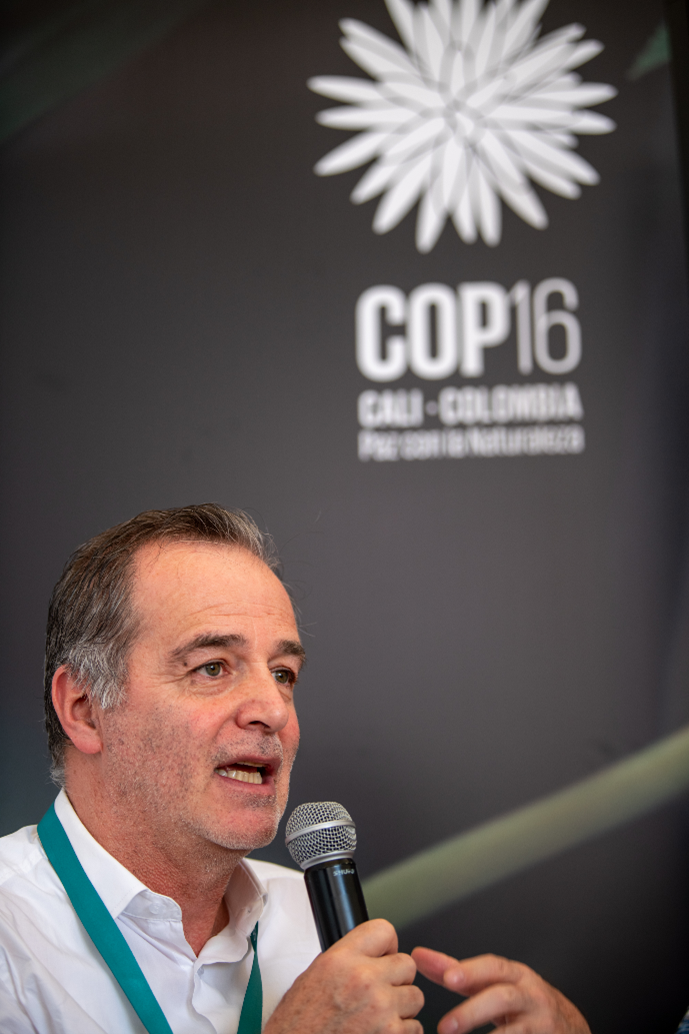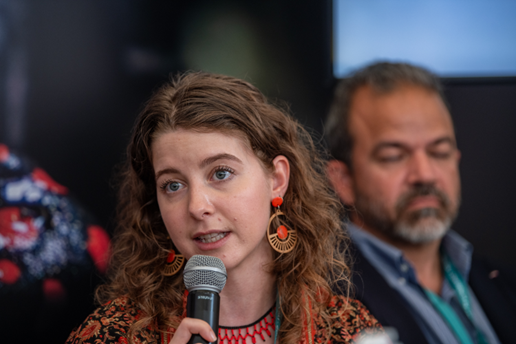Event Title: How Does Plant Diversity Respond to Climate Change?
On October 24, a distinguished side event, “How Does Plant Diversity Respond to Climate Change?” convened at COP16’s Academic and Research Hub, Place Quebec in the Blue Zone. Organised and moderated by Minxue Tang, a LEMONTREE PhD researcher from Imperial College London (ICL), cooperating with colleague Jiaze Li (also from ICL), the event brought together a diverse group of experts to address the complex interactions between biodiversity and climate change. This interdisciplinary session echoed the goals of COP16’s Agenda Item 23 on “Plant Conservation” and Agenda Item 25 on “Biodiversity and Climate Change.”
The event was a resounding success, attracting media representatives and participants eager to engage in meaningful dialogues. It demonstrated LEMONTREE’s commitment to addressing critical global challenges through innovative research and collaborative efforts.

Oscar Francisco Puerta Luchini, Director of Integrated Water Resource Management at the Ministry of Environment and Sustainable Development of Colombia, opened the event with remarks on Colombia’s commitment to sustainable development. He emphasised the essential role of terrestrial and aquatic ecosystems and highlighted the need to manage water resources carefully to enhance biodiversity resilience in a changing climate.
Figure 1. Opening remarks by Oscar Francisco Puerta Luchini,
Director of Integrated Water Resources Management at the
Ministry of Environment and Sustainable Development of Colombia.

Minxue Tang, ICL, presented her research on how, when and why European tree distributions have shifted during the past 12000 years. Utilising comprehensive fossil pollen records alongside advanced mathematical modelling techniques, Tang reconstructed historical climate change and plant migration patterns. Her findings explore the intricate relationship between tree history and climate dynamics, showcasing valuable insights into how past ecological shifts can inform our understanding and approaches to future climate scenarios.
Figure 2. Minxue Tang (ICL) delivered her research at the event.

Jiaze Li, ICL, discussed how spatio-temporal climate changes affect the global patterns of plant diversity through the lens of climate analogues. She explored the geography and movement of climate analogues and their impact on species richness of vascular plants over the past 56 million years, providing a framework for understanding how current climate shifts might influence future biodiversity trends.
Figure 3. Jiaze Li (ICL) showcasing her research.

Audrey Wagner from the University of Oxford discussed how tree diversity influences carbon sequestration. She emphasized that greater tree diversity not only enhances carbon storage but also contributes to ecosystem resilience against climate change. This connection highlights the synergies between climate action and biodiversity conservation, reinforcing the importance of diverse ecosystems in climate mitigation strategies.
Figure 4. Audrey Wagner from the University of Oxford.

Tanya Berger-Wolf, Director of Ohio State University’s Translational Data Analytics Institute, presented the challenges and opportunities for artificial intelligence in biodiversity conservation, as outlined in a the Global Partnership on AI report. She highlighted innovative solutions emerging from the rapidly growing AI and tech conservation community, showcasing how these advancements can help address the pressing challenges facing biodiversity today.
Figure 5. Tanya Berger-Wolf, Director of Ohio State University’s
Translational Data Analytics Institute

Paula Andrea Vilgas González, civil engineer from the Ministry of Environment and Sustainable Development of Colombia, presented on the La Mojana ecological restoration initiative, which focuses on community-driven biodiversity restoration through the planting of resilient, native species. This program exemplifies Colombia’s dedication to fostering ecological resilience and local engagement.
Figure 6. Paula Andrea Vilgas Gonzáalez, civil engineer from the
Ministry of Environment and Sustainable Development of Columbia.

Abel Baerga-Ortiz, Director of the Center for Tropical Biodiversity at the Puerto Rico Science Trust, focused on efforts in Puerto Rico to ensure the protection and sustainable use of biodiversity, reflecting on the impact of climate change and rising sea levels on coastal ecosystems.
Figure 7. Abel Baerga-Ortiz, Director of the Center for Tropical
Biodiversity at the Puerto Rico Science Trust

Fabricio Muriana from the Global Alliance for the Future of Food discussed agroecological practices in the Amazon, emphasizing the importance of climate justice in regions like Brazil. He highlighted how these practices enhance agricultural resilience while supporting biodiversity conservation and addressing the impacts of climate change on vulnerable communities.
Figure 8. Fabricio Muriana from the Global Alliance for the Future of Food.

Youth climate activist Roaa Alobeid, from the Sudan government and part of YOUNGO’s Global Coordination Team, delivered an inspiring address stressing the importance of intergenerational collaboration in climate advocacy. Representing youth voices, she called for immediate and ambitious actions to secure a sustainable future, underscoring the role of young leaders in bridging research, policy, and grassroots activism.
This event was more than a platform for knowledge exchange; it represented a vital opportunity for interdisciplinary dialogue and collaboration. It underscores LEMONTREE’s leadership in research and solutions for climate change. The organizers are proud of the event’s impact and look forward to sharing its outcomes and insights with a wider audience, reaffirming their commitment to fostering a sustainable future.
Figure 9. Youth climate activist Roaa Alobeid.
Event Title: Academia and Research Actions for the CBD Global Biodiversity Framework
On October 26, during COP16, Academia and Research Actions for the CBD Global Biodiversity Framework was held at the Multistakeholder Auditorium, Place Quebec in the Blue Zone. This event showcased the extensive contributions of academia and research to achieving the Kunming-Montreal Global Biodiversity Framework (GBF) goals.
David Obura, Chair of the Intergovernmental Science-Policy Platform on Biodiversity and Ecosystem Services (IPBES), delivered the opening address, underscoring the role of science in shaping biodiversity policy. With over 130 member countries, IPBES supports global biodiversity efforts by providing objective, evidence-based assessments of ecosystems and their benefits to humanity.
A key feature of the event was a series of academic flash talks, where Minxue Tang and Jiaze Li continued their discussions from October 24.
Minxue shared further insights from her research on climate change’s impact on biodiversity, and its relevance to the GBF targets, especially Target 8 (minimizing climate change impacts on biodiversity) and Target 10 (ecosystem restoration). Her findings demonstrated how some species demonstrate clear, climate-driven migration patterns, while others show more complex responses. These findings are highly relevant to Latin American forests, particularly the Amazon and the Andes, as they can inform targeted conservation and restoration efforts. Minxue highlighted methodologies for optimizing ecosystem restoration based on historical climate data and species migration trends. Her insights contribute directly to GBF Target 10, suggesting that prioritising species with demonstrated resilience to climate changes could strengthen ecosystem stability in Latin America.
She also underscored the importance of creating well-connected protected areas to facilitate species migration, which is essential for preserving biodiversity in rapidly changing climates. Furthermore, she noted that this approach is particularly relevant to regions like the Andes, where complex topographies act both as migration refuges and potential barriers. Following her presentation, David Obura engaged with Minxue in a meaningful exchange about the dual role of the Andes.

Figure 10. David Obura, Chair of IPBES, and Minxue Tang from Imperial College London exchanging views.
Jiaze’s research helps explain why the tropics have more species than higher latitudes: analogues of recent tropical climates emerged earlier and are more prevalent across space and time. This work inspires the potential application of ‘climate analogues’ to identify regions at risk and potential biodiversity refuges under ongoing climate change, supporting Targets 1-3 of GBF on conserving and restoring threatened ecosystems. Jiaze’s findings also emphasise the need to integrate both temporal and spatial scales when studying the impacts of climate change on biodiversity, which directly contributes to the GBF Target 8. In addition, by providing the most comprehensive and accurate global plant diversity data to date, this work supports GBF Target 21 by enhancing biodiversity knowledge to guide biodiversity action.
These sessions not only strengthened ties between academia, policymakers, NGOs, and industry leaders but also laid a foundation for future biodiversity conservation efforts. As COP16 continued, there was a strong anticipation for more interdisciplinary collaborations dedicated to addressing the global biodiversity crisis.
Written by Minxue Tang
Edited by Natalie Sanders
Photographed by Jiaze Li, Philipp Montenegro
